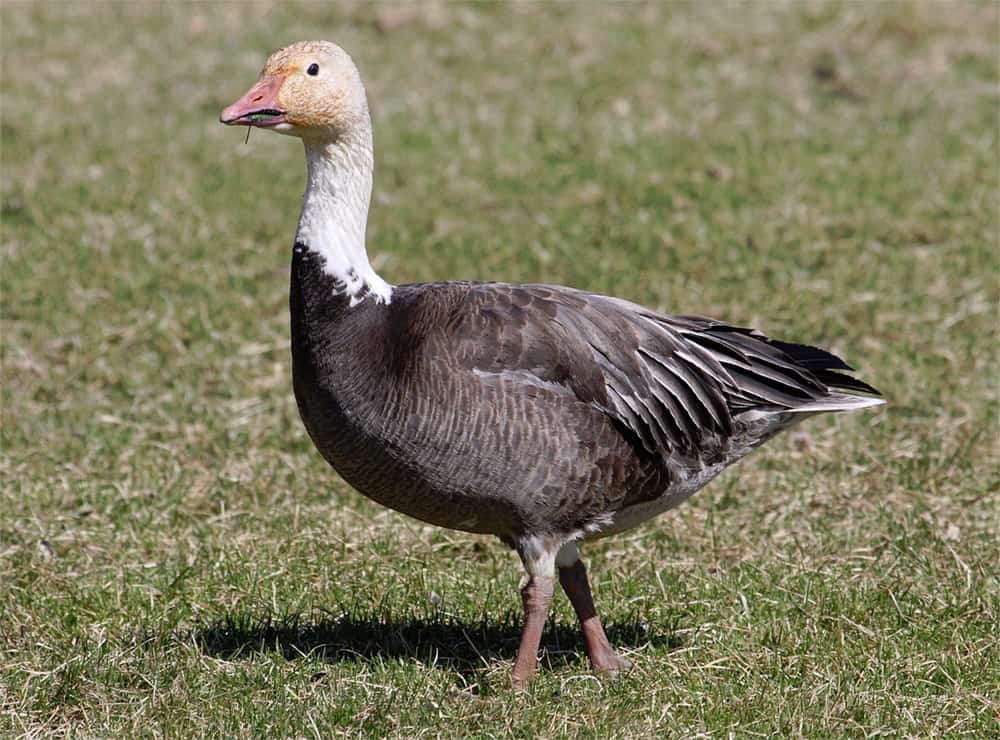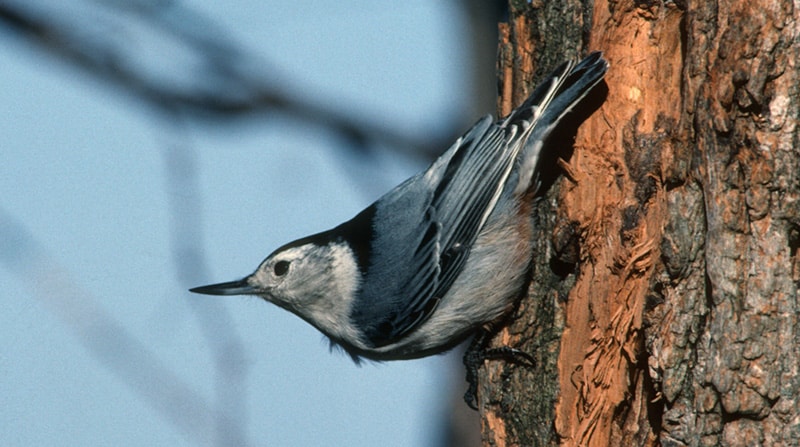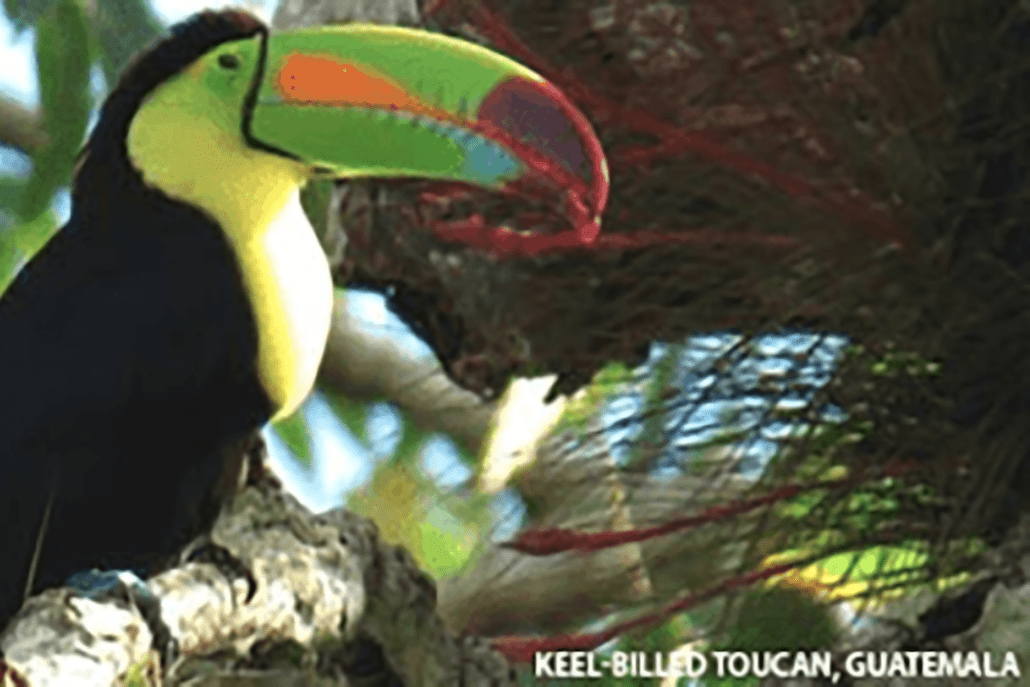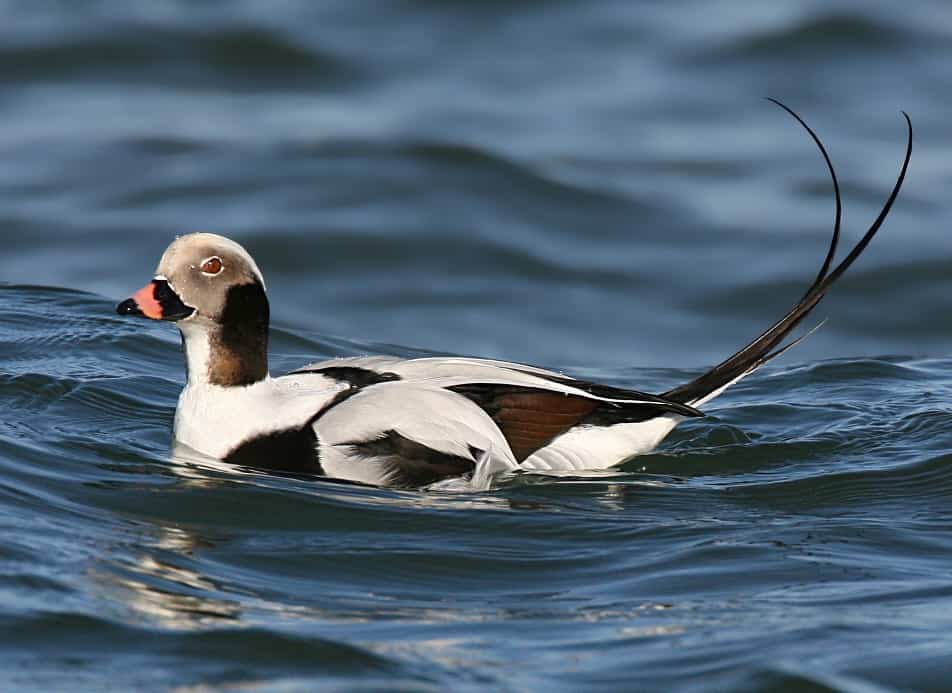Because Missouri is a crossroads where prairies meet the flora and fauna of both the North and the South, the state offers its Midwestern visitors an opportunity to see a wide variety of avian and plant species not found in neighboring Upper Midwestern states.
A bird watcher staying in Columbia at the junction of Interstate 70 and U.S. Highway 63 need not drive more than four hours in any direction to find members of the 10 Must-See Birds list. And all can be found at one or more of the Ten Great Birding Spots.
1. Eurasian Tree Sparrow
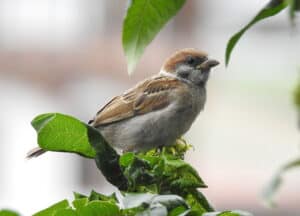
Missouri’s most sought-after bird is the Eurasian tree sparrow. Like its first cousin, the house sparrow, it is an introduced species, arriving in St. Louis in 1870 when two dozen birds were released in Lafayette Park. In the past three decades it has expanded its range west and north slightly, but can be expected only on any given day in the St. Louis area.
The Eurasian tree sparrow can easily be overlooked. It shares its limited habitat with the house sparrow, flocking in the winter like its cousin, often in the same habitat. The tree sparrow is slightly smaller than the house sparrow and much less aggressive and quarrelsome. Tree sparrows have chocolate-brown crowns, black throats, white cheeks with a black cheek patch, but not the dark breast of the male house sparrow. House sparrows have a gray crown and lack the obvious black face patch. Both sexes of tree sparrow are marked identically and all plumages maintain the brown crown.
Winter offers the best chance to find tree sparrows. Large flocks can be found at Riverlands Environmental Developmental Area. Look for them anyplace in the area, particularly in the brushy edges of the Mississippi River.
North Riverfront Park is home to tree sparrows year-round, including several pairs of breeding birds present from early April through summer.
The birds may be found throughout the St. Louis area. For current status and locations, birders should contact Webster Groves Nature Study Society at 314-935-8432.
2. Painted Bunting
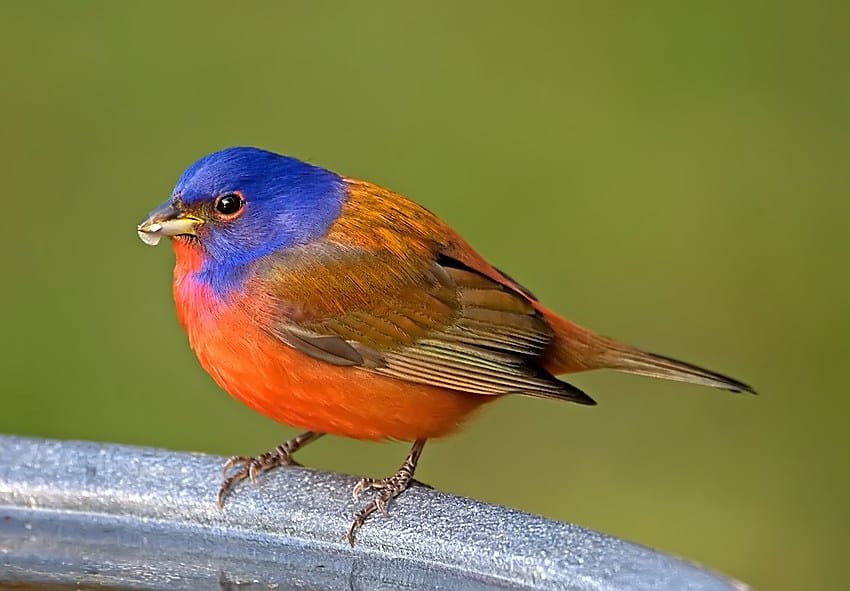
Unquestionably the most colorful wild bird you’ll encounter in Missouri is the painted bunting. The male sports bright red underparts and rump, a green back, a purple head, and a red eye ring. The female is green above, lighter below.
The painted bunting prefers dense thickets, but will come to bird feeders. Its song is much like that of the more-widespread indigo bunting and it often perches high to sing like the indigo. Once sold as a cage bird, the painted bunting was originally called “nonpareil,” because of its unparalleled beauty.
Painted buntings are rare in Missouri, but they can be found in the southwestern corner of the state from early May until mid-September. Because the songs of the indigo and the painted buntings are alike, it behooves a birder to check out every bunting song within the limited range of the painted bunting. The birds nest only on limestone glades and for years have returned to Newton County, nesting near Diamond and the George Washington Carver National Monument. The nesting area is located three miles west of Diamond via Route V to Marten Road.
Another spot where painted buntings are often found is in the Henning Conservation Area in Taney County. You must first get to Branson, the famed country-western music mecca an hour south of Springfield. Henning CA is 5 1/2 miles west of Branson on Rt. 76. Look for the parking lot on the right, but be there early; like all buntings, they’ll sing most actively between 6 and 8:30 a.m
3. Scissor-tailed Flycatcher
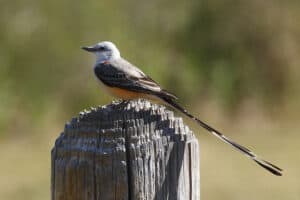
One of the most spectacular feeding activities in the world of birds is the interrupted flight of the scissor-tailed flycatcher. When the bird leaves its perch to dart out, flycatcher-style, after a flying insect, it spreads its long, forked tail in a “chair” upon which it “sits” momentarily to take better aim at lunch.
Visually, the bird is unmistakable. It is pearly gray above and below with salmon-pink sides and belly, and a very long (up to seven inches) tail, which is deeply forked and black and white. The female is slightly smaller and does not have the extremely long tail.
The scissor-tail was first reported in Missouri in the decade following the Civil War and was a bird of the southwest corner of the state. In the past half-century scissor-tails have expanded their range north to the Missouri River and may be seen hunting from wires, posts, and trees along major roads in open areas in the southwest quarter of the state.
Though they are often found in the Kansas City area and recently crossed the Missouri River in central Missouri, the best place to find scissor-tails is in the Osage Plains. The female is slightly smaller and does not have the extremely long tail.
There is seldom need to hunt for the scissor-tail in its normal range. It appears by mid-April and stays around until the insect population diminishes, often as late as November 1. You can hardly miss the guy with the long tail, sitting on the wires, fences, and other exposed perches.
4. Western Kingbird
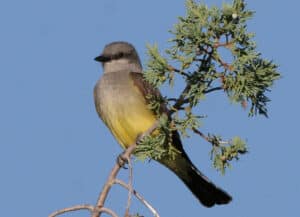
A rare but consistent breeder in western Missouri, the western kingbird is not a guaranteed addition to a visiting birder’s list, but it can usually be found from the Kansas City area north to the Iowa border. It is a distinctive bird with its gray back, head, and breast, its white throat, and its bright-yellow belly. The tail is black, outlined in white. The while tail outline distinguishes it from the lookalike Couch’s and tropical kingbirds, two tropical species not found in Missouri.
The western kingbird’s habits differ very little from those of the more common eastern kingbird. Since both species share the upper Great Plains states, finding the western variety in Missouri is no surprise. The first birds appear in mid-May and depart by late September. They prefer to nest on utility poles and seem to share a neighborhood comfortably with humans.
The western kingbird seems to be one species that has benefited from the cutting of timber. It prefers open spaces and seems to moving continually eastward. It has nested in St. Louis, the Bootheel, and in Joplin in recent years, as well as Columbia. Seeing it anywhere in the state is no surprise.
The most likely area for this species is in the Kansas City–St. Joseph corridor. A call to either the Burroughs Audubon Society in Kansas City at 816-795-8177 or the Midland Empire Audubon Society in St. Joseph at 816-364-4702 should be helpful.
5. Prothonotary Warbler
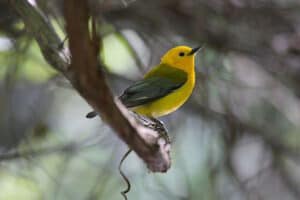
Another of the brilliantly colored summer nesters in Missouri is the prothonotary warbler. The head, neck, breast and belly are brilliant yellow set off by a prominent black eye. The wings are metallic blue-gray and the undertail coverts are white. The female is less brilliant in color.
The prothonotary is a bird of the swamps and streams, normally found around water with standing dead trees—especially trees with old woodpecker holes. It is a cavity nester and uses the woodpecker cavities for nesting. It will also use nest boxes placed in appropriate habitat. It is abundant in the Mississippi Lowlands but is quite common throughout most of southern Missouri. The song is a ringing sweet, sweet, sweet, sweet, sweet, sweet. The loud, ringing song and the brilliant yellow plumage make the prothonotary one of the most obvious summer residents of its habitat.
If you want a “guaranteed” prothonotary, the best bet is Big Oak Tree State Park near East Prairie in Mississippi County. Other popular sites where the prothonotary is common are Mingo NWR and at Eagle Rock in Stone County.
In North Missouri, the “swamp canaries” can be found in such popular birding stops as Swan Lake NWR, Fountain Grove Conservation Area, Blue Springs Lake near Kansas City, and Little Bean Marsh near St. Joseph. In the St. Louis area, they can easily be found at Busch Wildlife Area, on the river trail at Shaw Nature Reserve, and in Cane Bottom in Meramec State Park.
6. Swainson’s Warbler
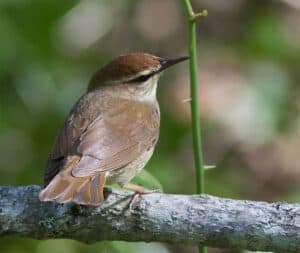
Finding this rare, rather drab inhabitant of the canebrakes in the southernmost tier of counties in Missouri will be a birding challenge worth the effort, leaving one with a sense of accomplishment. First reported in Missouri in 1950, the shy Swainson’s warbler is at the northern limit of its range in the Show-Me State. It prefers remote habitat—cane thickets and impenetrable swampy areas where it would be overlooked were it not for its song of three notes—whee, whee, whee, followed by rapidly descending notes sounding like whip poor will.
There are few distinguishing features to make identification of Swainson’s warbler easy in the wild. The bird has a brown crown, is olive-brown above and gray below. A pale eyebrow separates the crown from a dark eyeline. On the ground, it walks and shivers as it works through the leaf litter.
Finding a Swainson’s is best accomplished by floating the National Scenic Current River or the Eleven Point River in Shannon arid Oregon Counties. At Eleven Point, a person can often find a Swainson’s warbler without a canoe. Park at a campground where Missouri Highway 19 crosses the Eleven Point and work the cane along the river. You may be rewarded with a hooded warbler as well as a Swainson’s. The warblers arrive by late April and are gone by early September. Swainson’s have been recorded from Busch Wildlife Area near St. Louis and from Taney County, but if they are your target bird, the counties of Oregon, Shannon, and Dent are your best bets.
7. Black Vulture
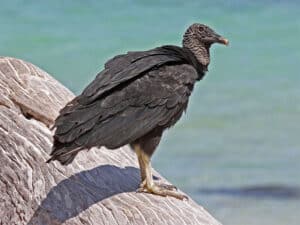
The black vulture, which just may be the best scavenger in the Western Hemisphere, has become a permanent resident of Missouri, breeding in the southern quarter of the state from Barry County in the west to the Mississippi River. It is an easy bird to identify in a flock of circling turkey vultures. Black vultures have broader wings with white primaries and gray feet. Their tails are much shorter; the wings are flat instead of the shallow V-shape of the turkey vulture.
The black vulture’s wingbeats are much faster—almost appearing that the bird is panicked about staying in the air. Black vultures have less ability to soar than their cousins do and flap much more with short glides. They are also much more aggressive than turkey vultures, often driving them away from carrion and roadkills. They have little fear of humans and large flocks work garbage dumps around major cities worldwide.
One sure place to find black vultures year-round is Shepherd of the Hills Fish Hatchery at Table Rock Dam in Taney County. The first winter roost was discovered here in 1986. In the eastern part of the state, black vultures can be expected in summer months along the Eleven Point River, at Mingo NWR, and at nearby Duck Creek Conservation Area. The Mingo Christmas Bird Count, traditionally the state’s most productive, often has black vultures on its summary tally. Occasionally black vultures drift north, but they have remained breeders and/or winter residents only in southern Missouri. Their range has expanded little in the past century.
8. Roadrunner
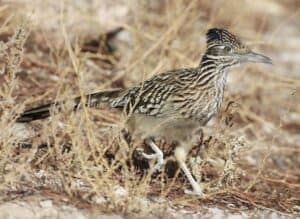
Like the painted bunting, the roadrunner is an easy bird to identify. It is a bird of the Southwest that ranges north to Southwest Missouri, where it has expanded its range little in the half-century since it was first reported in the state. It is crow-sized, long-legged, long-tailed, streaked gray and brown, with a bright yellow eye, and a bushy crest that it elevates when excited. The roadrunner prefers open areas with tickets in which to dodge around and in which to hide. Called the “chaparral cock” by early cowboys, it prefers running to flight and is unmistakable as it darts in and out of cover.
In Missouri, the roadrunner is a rare resident year-round, living primarily in four counties—Barry, Stone, Newton, and Taney. Though it is a bird of dry cedar glades, it may appear anywhere at any time. It is the raccoon of the bird world, popping up in urban areas, residential yards, and open fields. Like the cartoon character, if is there one moment, gone the next. And it will, indeed, run the roads.
The roadrunner is a fair bet at the Henning Conservation Area, an area that is described in the painted bunting notes. It often hustles leftovers in the parking lot. Another spot where the roadrunner is often seen is at Wolf pen Gap near Eagle Rock in Barry County.
Roadrunners speak a different language, primarily cooing, but with occasional clucks, crows, whines, and guttural croaks.
9. Greater Prairie-Chicken
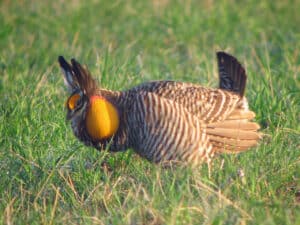
The greater prairie-chicken, a resident of the virgin tallgrass prairie, once numbered a million birds across northern and western Missouri. Today, no more than 3,000 remain in the state with two-thirds of the population located in Barton and Dade counties in west-central Missouri.
A chicken-sized bird, the greater prairie-chicken is heavily barred, deep brown and gray above and below, with a short, dark tail. The male has orange air sacs on the neck, which become inflated during courtship.
Leks, or breeding display grounds, can be found in northern Missouri (Dunn Ranch) and in Audrain county near Mexico, but the majority are located in the prairie areas from Hi Lonesome Prairie south to Sedalia and Prairie State Park north of Joplin.
Displays begin in early March and continue for a month. The show usually begins in pre-dawn darkness; the birds can be heard before they are seen. The males begin a loud cooing, which becomes a hum so loud it can be heard for a mile.
The air sacs on the neck fill with air, feathers on the neck become erect and appear to be horns. The males strut, stomp their feet, often leaping and whirling in the air, adding clucking and cackling to their “booming.” The males make short runs at each other, heads down, horns and tails up. A morning at the lek is a morning you’ll never forget.
10. Snow Goose
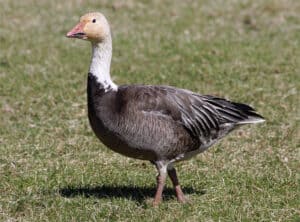
Missouri’s most spectacular and numerous visitor may be the snow goose. Up to half a million fill the refuges, fields, and skies of northwest Missouri beginning in late October, and weather permitting, loiter through winter in numbers stabilizing at about 150,000.
There are two color morphs of the species, and the blue morph was called the blue goose for many years and considered a separate species. The two morphs interbreed readily and today are considered as a single species. The white morph is all white except for black primaries and slate-gray primary coverts. The blue phase has a slaty to brown body with both primaries and secondaries black and all coverts slate-gray. The neck and head are white. Color patterns vary greatly, but the head and neck always remain white. Both morphs show a “grinning” patch on the lower mandible. The black patch on the pinkish bill gives the impression that the bird is grinning at your presence.
That “smile” is one difference between the snow and the Ross’s goose, which often migrates in small numbers with the snows. The snow’s “grin,” longer neck, and much flatter head, along with the Ross’s deep pink-red bill and noticeably smaller size, separate the species in a crowd.
Squaw Creek NWR is the major stop for snows and blues and the major overwintering spot. The early winter skies around Squaw Creek are filled as huge flights of geese rise noisily from the pools and head into the fields for miles around to feed.

